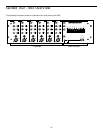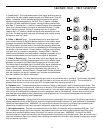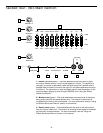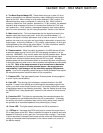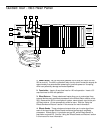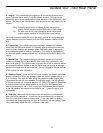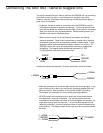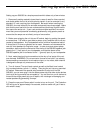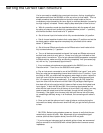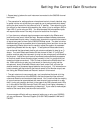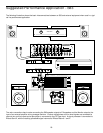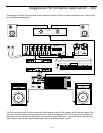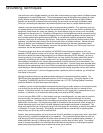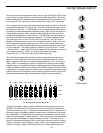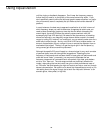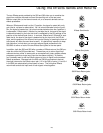
18
You’re now ready to establish the correct gain structure—the key to getting the
best performance from the S83/S63, or from any mixer, for that matter. This is a
simple procedure that ensures optimum input and output levels so that no
unnecessary noise (caused by too low a signal) or overload distortion (caused by
too high a signal) is created. Here’s a step-by-step description of how to do so:
a. With all connections made (as described above) but with the power off, start
by setting all channel level controls fully counterclockwise (to their “∞” position),
and then set the Main Level knob to its “0” position.
b. Set all channel input trim knobs to their fully counterclockwise (+4) position.
c. Set all channel equalizer knobs to their center detent “0” positions and set the
ten-band graphic master equalizer completely flat (all sliders at their center
detent “0” positions).
d. Set all channel Effects send knobs and all Effects return level knobs to their
fully counterclockwise (“∞”) position.
e. Turn on all devices connected to channel line inputs and Effects returns and
set their level controls to unity gain or, if there is no unity gain indicated on their
output control, to maximum. If you’ve got outboard effects processors connected
to Effects returns, make sure they are sending completely “wet” (processed) sig-
nal, with no “dry” (unprocessed) signal mixed in.
f. If any condenser microphones are connected to the S83/S63, turn on the
Phantom switch.* Then turn on the S83/S63’s main power.
g. Play an instrument connected to one of the S83/S63’s line inputs** and, while
doing so, raise the corresponding channel level control to the “0” position. If you
are using an S83, you should see the segment meter begin to move—adjust the
input trim control for that channel so that the “0” segment lights frequently and
the “+2” segment lights only occasionally. If you are using an S63, adjust the
input trim control for that channel until the Peak LED just begins flashing and
then back off just to the point at which it does not flash at even the highest level
input signals. In both the S83 and S63, if the incoming signal seems too hot
even with the input channel trim all the way at its minimum (+4) setting, you may
need to lower the output level of the instrument, though this will rarely occur.
Conversely, if the signal is too low even with the input channel trim all the way
up, something’s definitely wrong: in all likelihood, the connecting audio cable is
faulty.
h. Once you’ve set the optimum level in step (g) above, continue playing the
instrument and slowly raise the main level knob until you get the level you want
to hear.
* CAUTION: Before turning phantom power on, be sure to verify that the con-
nected mic(s) require 48 volts. Also, disconnect all non-microphone signal
sources (such as direct injection boxes) from the XLR mic jacks.
** If you’re using an instrument such as electric guitar or bass, we recommend
that you connect it to the S83/S63 with a direct injection box to ensure correct
impedance.
Setting the Correct Gain Structure



